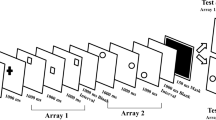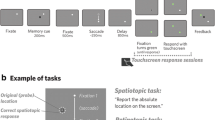Abstract
Pointing with an unseen hand to a visual target that disappears prior to movement requires maintaining a memory representation about the target location. The target location can be transformed either into a hand-centered frame of reference during target presentation and remembered under that form, or remembered in terms of retinal and extra-retinal cues and transformed into a body-centered frame of reference before movement initiation. The main goal of the present study was to investigate whether the target is stored in memory in an eye-centered frame, a hand-centered frame or in both frames of reference concomitantly. The task was to locate, memorize, and point to a target in a dark environment. Hand movement was not visible. During the recall delay, participants were asked to move their hand or their eyes in order to disrupt the memory representation of the target. Movement of the eyes during the recall delay was expected to disrupt an eye-centered memory representation whereas movement of the hand was expected to disrupt a hand-centered memory representation by increasing movement variability to the target. Variability of movement amplitude and direction was examined. Results showed that participants were more variable on the directional component of the movement when required to move their hand during recall delay. On the contrary, moving the eyes caused an increase in variability only in the amplitude component of the pointing movement. Taken together, these results suggest that the direction of the movement is coded and remembered in a frame of reference linked to the arm, whereas the amplitude of the movement is remembered in an eye-centered frame of reference.



Similar content being viewed by others
References
Atkeson CG, Hollerbach JM (1985) Kinematic features of unrestrained vertical arm movements. J Neurosci 5:2318–2330
Baddeley AD (1986) Working memory. Oxford University Press, Oxford
Bennett PJ, Sekuler AB, McIntosh AR, Della-Maggiore V (2001) The effects of aging on visual memory: evidence for functional reorganization of cortical networks. Acta Psychol 107:249–73
Berkinblit MB, Fookson OI, Smetanin B, Adamovich SV, Poizner H (1995) The interaction of visual and proprioceptive inputs in pointing to actual and remembered targets. Exp Brain Res 107:326–330
Bock O (1986) Contribution of retinal versus extraretinal signals towards visual localization in goal-directed movements. Exp Brain Res 64:476–482
Bock O (1993) Localization of objects in the peripheral visual field. Behav Brain Res 56:77–84
Bock O, Arnold K (1993) Error accumulation and error correction in sequential pointing movements. Exp Brain Res 95:111–117
Bridgeman B, Graziano JA (1989) Effect of context and efference copy on visual straight ahead. Vision Res 29:1729–1736
Buneo CA, Jarvis MR, Batista AP, Andersen RA (2002) Direct visuomotor transformations for reaching. Nature 416:632–636
Carrozzo M, McIntyre J, Zago M, Lacquaniti F (1999) Viewer-centered and body-centered frames of reference in direct visuomotor transformations. Exp Brain Res 129:201–210
Chieffi S, Allport DA, Woodin M (1999) Hand-centred coding of target location in visuo-spatial working memory. Neuropsychologia 37:495–502
Churchill A, Hopkins B, Rönnqvist L, Vogt S (2000) Vision of the hand and environmental context in human prehension. Exp Brain Res 134:81–89
Coello Y, Magne P (2000) Determination of target distance in a structured environment: selection of visual information for action. Eur J Cogn Psychol 12:489–519
Darling WG, Miller GF (1993) Transformation between visual and kinesthetic coordinate systems in reaches to remembered objects locations and orientations. Exp Brain Res 93:534–547
Elliott D, Madalena J (1987) The influence of premovement visual information on manual aiming. Q J Exp Psychol 39A:541–559
Enright JT (1995) The non-visual impact of eye orientation on eye-hand coordination. Vision Res 35:1611–1618
Flanders M, Helms-Tillery SI, Soechting JF (1992) Early stages in sensorimotor transformation. Behav Brain Sci 15:309–362
Georgopoulos AP (1997) Motor cortex: neural and computational studies. In: Donahoe JW, Packard Dorsel V (eds) Neural networks models of cognition. Elsevier, Amsterdam
Gordon J, Ghilardi MF, Ghez C (1994) Accuracy of planar reaching movement I. Independence of direction and extent variability. Exp Brain Res 99:97–111
Graaf JB de, Sittig AC, Denier van der Gon JJ (1994) Misdirections in slow, goal-directed movements are not primarily visually-based. Exp Brain Res 99:464–472
Grealy MA, Coello Y, Heffernan D (2003) Apparent motion cues distort object localization in egocentric space. Exp Brain Res 150:356–362
Guay M (1986) Proactive interference and intertrial interval in short-term retention of temporal visual information. Percept Mot Skills 63:839–846
Guay M, Hall CR (1984) Rehearsal of temporal visual information. Percept Mot Skills 215–220
Henriques DY, Crawford JD (2002) Role of eye, head, and shoulder geometry in the planning of accurate arm movements. J Neurophysiol 87:1677–1685
Henriques DY, Klier EM, Smith MA, Lowy D, Crawford JD (1998) Gaze-centered remapping of remembered visual space in an open-loop pointing task. J Neurosci 18:1583–1594
Keele SW (1986) Motor control. In Boff KR, Kaufman L, Thomas JP (eds) Handbook of perception and performance. Wiley, New York, pp 1–60
Kurata K (1993) Premotor cortex of monkeys: set- and movement-related activity reflecting amplitude and direction of wrist movements. J Neurophysiol 69:187–200
Laabs GJ (1973) Retention characteristics of different reproduction cues in motor short-term memory. J Exp Psychol 100:168–177
Lemay M, Proteau L (2001) A distance effect in a manual aiming task to remembered targets: a test of three hypotheses. Exp Brain Res 140:357–368
Lemay M, Proteau L (2002) The effects of target presentation time, recall delay and aging on the accuracy of manual pointing to remembered targets. J Mot Behav 34:11–23
Logie RH (1995) Visuo-spatial working memory. Lawrence Erlbaum Associates, Hove, UK
Logie RH, Marchetti C (1991) Visuo-spatial working memory: visual, spatial or central executive?. In: Logie RH, Denis M (eds) Mental images in human cognition. North Holland Press, Amsterdam, pp 105–115
McIntyre J, Stratta F, Lacquaniti F (1997) Viewer-centered frame of reference for pointing to memorized targets in three-dimensional space [published errata appear in J Neurophysiol 1998 Mar,79(3):preceding 1135 and 1998 Jun;79(6):3301]. J Neurophysiol 78:1601–1618
McIntyre J, Stratta F, Lacquaniti F (1998) Short-term memory for reaching to visual targets: psychophysical evidence for body-centered reference frames. J Neurosci 18:8423–8435
Messier J, Kalaska JF (1997) Differential effect of task conditions on errors of direction and extent of reaching movements. Exp Brain Res 115:469–478
Messier J, Kalaska JF (1999) Comparison of variability of initial kinematics and endpoints of reaching movements. Exp Brain Res 125:139–152
Neggers SF, Bekkering H (1999) Integration of visual and somatosensory target information in goal-directed eye and arm movements. Exp Brain Res 125:97–107
Pepper RL, Herman LM (1970) Decay and interference effects in the short-term retention of a discrete motor act. J Exp Psychol 83:1–18
Prablanc C, Echallier JF, Komilis E, Jeannerod M (1979) Optimal response of eye and hand motor systems in pointing at a visual target. I. Spatio-temporal characteristics of eye and hand movements and their relationship when varying the amount of visual information. Biol Cybern 35:113–124
Quinn JG, Ralston GE (1986) Movement and attention in visual working memory. Q J Exp Psychol A 38:689–703
Romero DH, Van Gemmert AWA, Adler CH, Bekkering H, Stelmach GE (2003) Altered aiming movements in Parkinson’s patients and elderly adults as a function of delays in movement onset. Exp Brain Res 151:249–261
Rosenbaum DA (1980) Human movement initiation: specification of arm, direction, and extent. J Exp Psychol Gen 109:444–474
Smyth MM, Pendleton LR (1989) Working memory for movements. Q J Exp Psychol A 41:235–250
Soechting JF, Flanders M (1989a) Sensorimotor representations for pointing to targets in three-dimensional space. J Neurophysiol 62:582–594
Soechting JF, Flanders M (1989b) Errors in pointing are due to approximations in sensorimotor transformations. J Neurophysiol 62:595–608
Soechting JF, Helms-Tillery SI, Flanders M (1990) Transformation from head-centered to shoulder-centered representation of target direction in arm movements. J Cogn Neurosci 2:32–43
Vindras P, Viviani P (1998) Frames of reference and control parameters in visuomanual pointing. J Exp Psychol Hum Percept Perform 24:569–591
Vindras P, Desmurget M, Prablanc C, Viviani P (1998) Pointing errors reflect biases in the perception of the initial hand position. J Neurophysiol 79:3290–3294
Wann JP, Ibrahim SF (1992) Does limb proprioception drift? Exp Brain Res 91:162–166
Author information
Authors and Affiliations
Corresponding author
Rights and permissions
About this article
Cite this article
Lemay, M., Stelmach, G.E. Multiple frames of reference for pointing to a remembered target. Exp Brain Res 164, 301–310 (2005). https://doi.org/10.1007/s00221-005-2249-2
Received:
Accepted:
Published:
Issue Date:
DOI: https://doi.org/10.1007/s00221-005-2249-2




